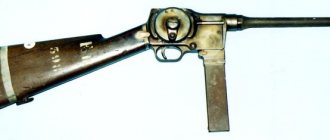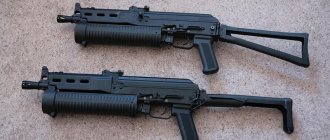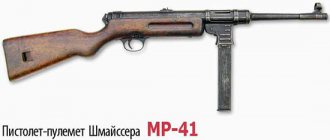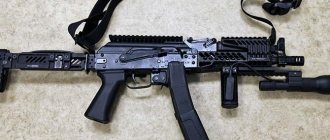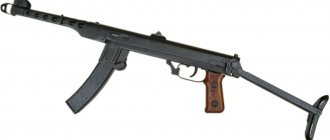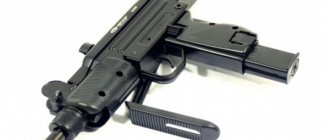At the end of the twentieth century, Russian law enforcement agencies and special army units showed increased interest in such seemingly forgotten small automatic weapons as the PP (submachine gun). In the 90s, these models began to be developed by employees of design bureaus in Izhevsk, Tula and Kovrov. Soon several such samples were presented to the attention of the Russian army and the Ministry of Internal Affairs. Among the most popular models is the Kashtan AEK-919K submachine gun (Russia).
Story
In the 90s, the three weapons capitals of the Russian Federation - Tula, Izhevsk and Kovrov - received orders from the FSB and the Ministry of Internal Affairs to manufacture personal firearms for their employees. At the same time, special attention was paid to ensuring that the size of the new models did not exceed pistols, but had a greater rate of fire and firepower. By 1994, employees of the Tula Design Bureau had assembled the OTs-2 "Cypress", the PP-91 "Kedr" was designed in Izhevsk, and in Kovrov, at a mechanical plant under the leadership of designer Pavel Sedov, the AEK-919K "Kashtan" submachine gun was assembled, intended for firing 9x18 mm caliber cartridges.
Notes
- Military Ka.
(November 29, 2016). Access date: July 8, 2022. - ↑ AEK-919K submachine gun // “Soldier of Fortune” magazine, No. 10 (145), 2006. pp.24-25
- L. E. Sytin.
All about firearms. - "Polygon", 2012. - P. 571. - 646 p. — ISBN 978-5-89173-565-1. - Demonstration samples presented at arms exhibitions were equipped with PK-23 and PK-23-01 collimator sights manufactured by BelOMO (Belarus) or PC Kashtan manufactured by Central Design Bureau Foton (Russia)
- “Chestnut” // A. I. Blagovestov. What they shoot from in the CIS: Directory of small arms. / under. general ed. A.E. Taras. Minsk, “Harvest”, 2000. p.215-217
- Chestnut. AEK-919K // “Master Gun” magazine, No. 62, May 2002. pp. 50-53
- Charlie Cutshaw. Russian small arms. New samples. M., EKSMO-Press, 2002. pp. 136-138
- AEK-918 - submachine gun with balanced automatics (Russian) // Weapons: magazine. - 2008. - August (No. 08). — P. 64-65.
- Alexander Kim. This is special forces! A separate special forces brigade of the Ministry of Defense celebrated the tenth anniversary of its existence // newspaper “MSN” dated April 6, 2004
- Decree of the Government of the Russian Federation No. 553 of 09/05/2003
- Order of the Ministry of Internal Affairs of the Russian Federation No. 611 of August 4, 2006 “On approval of lists of special means, types, types and models of firearms and gas weapons, cartridges and ammunition for them, standards for providing them to employees of paramilitary and guard units of the FSUE Okhrana of the Ministry of Internal Affairs of Russia ” (Appendix No. 2)
- Order of the Federal Service of the National Guard Troops of the Russian Federation No. 285 of August 16, 2022 “On approval of lists of types, types and models of combat hand-held small arms, service and civilian weapons, cartridges and ammunition for them, special means and standards for providing them to employees of paramilitary and guard units FSUE "Security" of the Federal Service of the National Guard Troops of the Russian Federation"
Basis for Russian PP
Since design work on this type of weapon had not been carried out since 1940, not a single model of a submachine gun entered service with the USSR. As a result, gunsmiths, who received the task from the FSB and the Ministry of Internal Affairs to create a domestic software, had to use foreign analogues in their work. Thus, when developing the AEK-919K Kashtan submachine gun, Russian weapons designers used the Austrian-made Steyr MPi-69.
Initially, a small batch of Russian PP was released. After testing the weapon, flaws were discovered in it. Their correction entailed significant design changes. As a result, a completely new model of automatic small arms was created, which today is known as the Kashtan submachine gun.
Modifications
A-545
Automatic A545 or 6P67, undergoing testing in 2014 as part of the “Warrior” program
Created to participate in a competition for a new general-arms assault rifle. Passed state tests in 2014 on the “Warrior” theme together with the AK-12 of the Kalashnikov concern, satisfying all the tactical and technical requirements of the Ministry of Defense of the Russian Federation. During tests, the A-545 showed better accuracy when firing in long bursts, but was inferior in terms of price-quality ratio. Based on the test results, it was decided to accept both assault rifles for military service during 2015. What distinguishes it from the base model is, first of all, a different receiver design (on the AEK-971 there is a removable cover), which allows you to attach a Picatinny rail to the assault rifle for the possibility of installation of various sights and a fire mode switch on both sides of the machine.
A-762
This variant uses the 7.62x39mm cartridge.
AEK-971 assault rifles were produced in small batches and were in service with special forces of the Ministry of Internal Affairs and other law enforcement agencies. In 2006, the production of military products was completely stopped at the Kovrov Machine-Building Plant. All production was transferred to the Kovrov plant named after Degtyarev (ZiD), but the deployment of production of AEK-971 series assault rifles at ZiD was suspended; setting up production required large preliminary costs, which could only be recouped if large orders were received for the new machine.
Device
The Kashtan submachine gun has an original design, copied from a foreign analogue. When traveling, the pistol is a small metal box that looks nothing like a weapon. The design consists of a stamped receiver equipped with two fields of notches, which are used as a forend. Front sights and rear sights are installed on the cover. Its left side became the location for a three-position safety lever. The stock is retractable and contains a rotating buttplate, which can be easily hidden in the receiver if necessary.
If the PP is unfolded, it will consist of a metal handle that contains the magazine and butt. After folding the folded sights and cocking the bolt, the weapon is considered ready to fire.
In the manufacture of the body for the Kashtan submachine gun, injection molded high-strength glass-filled plastic (glass-fiber reinforced polyamide filled) was used.
How is the fuse constructed?
The design of the trigger mechanism allows for single and automatic firing. To change the fire mode, a special flag translator is provided, which is equipped with the Kashtan software. The 9 mm submachine gun fires single shots if the translator is turned all the way clockwise. If you move it all the way in the opposite direction, the submachine gun will be on safety. By placing the checkbox in an intermediate position, you can fire bursts from the AEK-919K Kashtan submachine gun.
Reviews from those who have already tested this model indicate a very convenient location of the flag translator, which is easy to move with the thumb of your right hand.
Submachine gun AEK 919-K "Kashtan"
The end of the 20th century, namely its last decade, was marked in the Russian Federation by a renewed interest in an already seemingly forgotten type of small automatic weapons - submachine guns. Interest in the PP at that time showed both from law enforcement agencies and from special army units. The latter considered submachine guns as an auxiliary weapon option. Since the first half of the 90s of the last century, the design bureaus of Tula, Kovrov and Izhevsk have been actively involved in the creation of new models of submachine guns. Within a few years, the Ministry of Internal Affairs and the army could choose from no less than 7 samples of various PP, created for the 9x18 PM pistol cartridge. Among the presented samples were the Tula submachine gun "Cypress", created in the early 1970s on the theme "Berkut", from the leading designer of TsKIBSOO N. Afanasyev, and the Izhevsk submachine gun "Kedr" (designed by Evgeny Dragunov). Among the newly created samples of submachine guns was the AEK-919K “Kashtan” developed by the Kovrov Mechanical Plant (KMZ). Work on this software was initiated at the initiative of specialists from the factory SKB when the performance characteristics required for the model were agreed upon by the Ministry of Internal Affairs. The person responsible for the work on the project of the new submachine gun was the leading designer Pavel Sedov, who worked under the leadership of the head of the SKB Stanislav Koksharov and with the scientific support of Professor Mikhail Tarasov. The AEK-919K "Kashtan" PP created at KMZ supplied units of the Ministry of Internal Affairs, FSB, Ministry of Justice and FSO.
AEK-919K "Kashtan", created in the mid-1990s by specialists from the Kovrov Mechanical Plant, was developed with an eye on foreign analogues. The Austrian submachine gun Steyr MPi-69 was taken as the basis. But after the release of a small pilot batch of AEK-919, a number of shortcomings were discovered, and the design of the PP was redone. Changes made to the design led to the emergence of a new model, which received the AEK 919K “Chestnut” index. Kovrovtsy positioned the new submachine gun as a weapon for law enforcement agencies, special forces, as well as certain categories of military personnel of the Russian army (crews of combat vehicles and aircraft).
The body of the AEK 919K submachine gun was a fire control handle with a short fore-end and trigger guard. It was made of high-strength injection molded glass-filled plastic. The PP cartridges were fed using two types of magazines - 20 and 30 rounds, which were located in the weapon control handle. The stacking of cartridges in the magazines is staggered, with a double-row exit. The magazine is fixed in the handle using a special latch in the form of a button. The reloading handle is left-handed; during firing it remains motionless in the forward position.
The receiver of the PP AEK 919K is stamped; in the front part there are two fields of notches that act as a forend. There is a rear sight and front sight on the receiver cover. Flag-type safety switch, three-position. It is located on the left side of the receiver. The magazine receiver is located in the pistol grip. The submachine gun is equipped with a retractable buttstock equipped with a rotating butt pad. For convenient attachment to the shooter's shoulder, after extension, the shoulder rest rotates 180 degrees. In the stowed position, the butt is easily retracted into the receiver.
The automatic operation of the Kashtan submachine gun is based on the recoil energy of the free bolt. To reduce the size of the submachine gun, a bolt running over the barrel was used in its design (approximately 1/3 of the bolt in its extreme position is located above the barrel). The reloading handle is located on the left side of the receiver; it is not rigidly connected to the bolt. When firing, it is in the extreme forward position. The barrel with polygonal rifling is attached to the receiver using a removable coupling, which allows you to quickly replace the barrel.
The trigger mechanism of the AEK 919K "Kashtan" PP allows the shooter to fire both single shots and bursts. In order to change the firing mode, it is enough to use the flag translator located on the left side of the weapon above the trigger guard. This fire translator is a fuse. It is very easy to operate with the thumb located on the right hand. Turning the flag switch counterclockwise to the extreme position corresponds to installing the submachine gun on the safety catch. To fire single shots, the flag must be turned all the way in the opposite direction. Firing in bursts is possible when the flag is placed in an intermediate position.
The Kashtan submachine gun is equipped with sighting devices, which are a reversible rear sight and an adjustable front sight in a protective housing. The extreme positions of the rear sight correspond to firing distances of 50 and 100 meters. It is also possible to install a laser target designator and a collimator sight on the weapon.
Among other things, the Kashtan PP kit includes a quick-detachable muzzle attachment, which is designed for low-noise, flameless shooting. At the same time, the barrel of the submachine gun can be quite easily separated from the weapon, which, together with the polygonal rifling of the barrel bore, greatly facilitates the care of the weapon. The short length of the shoulder rest is sometimes cited as one of the disadvantages, but when using the AEK-919K “Kashtan”, equipped with a collimator sight, this is not so noticeable.
Unlike many other models of small arms, the Kashtan managed to gain experience in real combat use. It was first used in 1995 by special forces of the Russian FSB, which received a batch of 100 such submachine guns. FSB officers used them during the first Chechen campaign. In the early 2000s, the crews of the Ka-50 Black Shark attack helicopters, which were used in the combat zone in Chechnya and Dagestan, were armed with Kashtan submachine guns.
Performance characteristics of the AEK-919K “Kashtan”: Caliber: 9 mm. The weight of the weapon with magazine (20) (without ammunition) is no more than 1.8 kg. Dimensions with the butt folded - 355x55x190 mm. The length in the firing position with the butt extended is 500 mm. Height with a magazine for 30 rounds is at least 240 mm. Magazine capacity - 20 or 30 rounds. Cartridge type - 9x18 mm. The initial bullet speed is no more than 325 m/s. Rate of fire - no more than 1000 rounds/min. Firing mode - automatic/single.
Sources of information: https://www.dogswar.ru/strelkovoe-oryjie/pistolety-pylemety/3611-pistolet-pylemet-aek.html https://www.ois.org.ua/club/guns/texts/kashtan. htm https://gunsru.ru/rg_pistol-pulemet_kashtan_ru.html https://vitalykuzmin.net/?q=node/589 https://www.zid.ru/products/defence/44/detail/171
How does the shot happen?
The automatic weapon uses the recoil of the free shutter. In order to reduce the size of the submachine gun, Kovrov designers used a bolt design that slides onto the barrel and covers it from all sides. The bolt must be in the cocked position before firing. To do this, it is fixed on the rear sear of the trigger mechanism.
After the trigger is pressed, the bolt breaks off the sear, and the return spring begins to push it forward. During its movement, the bolt from the magazine captures ammunition and directs it into the barrel chamber. The shot is fired after the cartridge capsule is broken by the firing pin. The acceleration of the bullet in the barrel is carried out due to the resulting powder gases. They press on the bottom of the cartridge case, as a result of which the bolt stops and moves in the opposite direction. During his recoil, he removes the spent cartridge case. Compressing the return spring, the bolt is installed back behind the sear. The cycle repeats again after each pull of the trigger.
If the submachine gun is set to fire in bursts, the sear will remain in the recessed position, and the bolt will not stop moving until all the ammunition in the magazine runs out.
Extraction of spent cartridges to the outside is carried out by a spring-loaded ejector. On the damper below the guide spring there is a rod reflector, which also takes part in removing spent cartridges from the chamber. As evidenced by the reviews of those who have already fired from this submachine gun, thanks to the polygonal rifling, the barrels have a long service life.
Sights
The Kashtan SMG is capable of hitting enemy personnel at a distance of one hundred meters. Especially for these purposes, the weapon is equipped with sighting devices: a reversible rear sight and an adjustable front sight.
Additionally, a laser target designator/collimator sight can be installed on the submachine gun. Since this model of weapon is intended for special forces to perform narrowly focused tasks, tactical PMS silencers (low-noise firing devices) are often installed on the Kashtan SMG.
For this purpose, the front parts of the barrels of the Kashtan submachine guns are equipped with special couplings.
About tactical and technical characteristics
- The submachine gun is designed to fire 9 mm caliber cartridges.
- Weight of the PP (with magazine without cartridges) up to 1.8 kg.
- The dimensions of the weapon in the folded position are 335x55x190 mm.
- The length of the model with the butt unfolded is no more than 50 cm.
- The height of the PP, equipped with a magazine for 30 rounds of ammunition, does not exceed 24 cm.
- The fired bullet has a speed of up to 325 m/s.
- The rate of fire of the submachine gun is 100 shots per minute in a combat burst and 40 per minute in single shots.
- In automatic and single-fire modes, you can use the Kashtan submachine gun. There is no information about the price of this model, since it is not intended for sale.
Required Skills
Small Arms: Expert
– level
3
168000
Small arms: specialist
– level
5
150000
Small arms: novice
– level
5
25000
Accuracy: novice
level
3
7000
Damage:
– level
3
7000
Accuracy: novice
– level
5
25000
Damage: novice
– level
5
25000
Accuracy: specialist
- level
2
18000
Accuracy: beginner
- level
4
14000
Damage: specialist
- level
2
18000
Damage: beginner
- level
4
14000
Note.
The numbers in the superscript are the total experience for taking the skill, including previous levels. The number is absolute, i.e. it is indicated without character discounts for characteristics above 10.
| Required Experience | Components | |||||||||||||||||||||||||||||||||||||||||||||||||||||||||||||||||||||||||||||||||||||||||||||||||||||||||||||||||||||||
| Primary parameter | Secondary parameter | |||||||||||||||||||||||||||||||||||||||||||||||||||||||||||||||||||||||||||||||||||||||||||||||||||||||||||||||||||||||
| 429000 396825 |
| |||||||||||||||||||||||||||||||||||||||||||||||||||||||||||||||||||||||||||||||||||||||||||||||||||||||||||||||||||||||
|
|
|
|
|
|
|
|
|
|
|
Models
Three modifications were created based on the Kashtan submachine gun:
- AEK-919. Unlike its counterpart, this model is longer and heavier. In addition, the receiver at the top has a square cross-section, while in the basic PP the corners of the box are rounded.
- AEK-918. This is a development from 2000. Unlike its analogue, this model is designed to fire 9x19mm cartridges.
- AEK-918v. This submachine gun is considered a prototype for 9x19 Parabellum ammunition.



